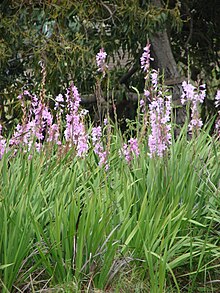Watsonia borbonica
| Watsonia borbonica | |
|---|---|

| |
| Scientific classification | |
| Kingdom: | Plantae |
| Clade: | Tracheophytes |
| Clade: | Angiosperms |
| Clade: | Monocots |
| Order: | Asparagales |
| Family: | Iridaceae |
| Genus: | Watsonia |
| Species: | W. borbonica
|
| Binomial name | |
| Watsonia borbonica (Pourr.) Goldblatt
| |
Watsonia borbonica, the Cape bugle-lily,[1] is a species of plant in the family Iridaceae that is native to South Africa.
Taxonomy[edit]
Watsonia borbonica has two subspecies: W. borbonica subsp. ardernei, and subsp. borbonica. W. borbonica subsp. ardernei is named in honour of H.M. Arderne, the Cape Town businessman whose family established the Arderne Gardens in Claremont . This subspecies is best known for its white form that is well-established in cultivation.[2]
Characteristics[edit]
The species grows from corms. It is dormant in summer and grows in winter, which is the rainy season in its native habitat. It has tall strap-like leaves growing in a fan arrangement. It may grow up to two metres tall. It flowers for up to 4–5 weeks in spring.
Distribution and habitat[edit]
Watsonia borbonica grows in the winter-rainfall areas of the Western Cape of South Africa. It usually grows on slopes consisting of rocky sandstone or clay and granite. It may be found occasionally in sandy soils.[3]
Cultivation[edit]
Watsonia borbonica is a good garden plant as it bears showy flowers. It needs well-drained soil and full sun. During the dormant phase it should be kept dry.[4]
References[edit]
- ^ USDA, NRCS (n.d.). "Watsonia borbonica". The PLANTS Database (plants.usda.gov). Greensboro, North Carolina: National Plant Data Team. Retrieved 7 August 2015.
- ^ "Watsonia borbonica | PlantZAfrica".
- ^ Nonkenge, S.; Notten, A. "Watsonia borbonica". SANBI. Retrieved 11 April 2013.
- ^ "Watsonia". Retrieved 11 April 2013.
